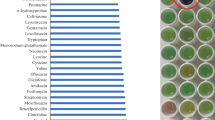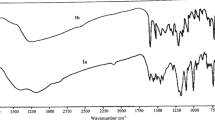Summary
Interactions of the cationic dye methylene blue with mercuric chloride have been studied conductometrically, analytically and spectrophotometrically. Methylene blue produces red colored precipitate with mercuric chloride; in presence of large excess of mercuric chloride a strong metachromasia is induced in the dye. Metachromasia induced by mercuric chloride is more hypsochromic as well as hypochromic than that induced by chromotopes like heparin. The complexes formed between methylene blue and mercuric chloride have variable compositions, the complex responsible for the red metachromatic color of the dye has the composition 2 dye: 1 HgCl2. A model has been proposed for the metachromatic complex consisting hexa-coordinated mercury, dye is coordinated to the mercury by donating the lone pair electrons of terminal nitrogen. The non-metachromatic dye capri blue also interacts with mercuric chloride but without any change in the visible spectrum. Potassium iodide also gives metachromatic reddish blue colored precipitate with methylene blue.
Similar content being viewed by others
References
Armstrong, R. W., Kurucsev, T., Strauss, U. P.: The interaction between acridine dyes and deoxyribonucleic acid. J. Amer. chem. Soc. 92, 3174–3181 (1970).
Basu, P. S., Biswas, B. B., Pal, M. K.: Review on Gram-staining. Int. Rev. Cytol. 29, 1–26 (1970).
Beaumont, T. G., Davis, K. M. C.: Complexes of hexaflourobenzene with n or π electron donors. J. chem. Soc. B 1131–1134 (1967).
Chandra, A. K., Mukherjee, D. C.: Molecular complexes of aniline with iodine and iodine monochloride. Trans. Farad. Soc. 60, Part I, 62–71 (1964).
Costanzo, S. J., Jurinski, N. B.: Charge transfer complexes of aluminum chloride. Tetrahedron 23 (6), 2571–2576 (1967).
Grdenic, D.: The structural chemistry of mercury. Quart. Rev. 19, 303–328 (1965).
Kodema, K.: Gravimetric estimation of mercury. Meth. Quant. Inorg. Analysis p., 153 (1963).
Mandal, N. C., Biswas, B. B., Pal, M. K.: Metachromasia induced by inositol hexaphosphate with toluidine blue. Histochemie 18, 202–209 (1969).
Pal, M. K., Biswas, M.: In preparation.
Pal, M. K., Biswas, M.: Small molecules as chromotropes in metachromasia. Histochemie 27, 36–42 (1971).
Pearse, A. G. E.: Histochemistry, p. 217. London: J. & A. Churchill Ltd. 1960.
Rahn, R. O., Landry, L. C., Battista, M. D. C., Setlow, J. K.: The interaction of mercuric ion with poly-nucleotides and DNA. 14th Ann. Meet., Biophys. Soc. p. 168a (1970).
Sur, S.: Donor—acceptor complex of p-benzoquinone and hydroquinone with amine and polar solvents. J. ind. chem. Soc. 49, 509 (1972).
Sylvén, B.: Metachromatic dye-substrate interactions. Quart. J. micr. Sci. 95, 327–358 (1954).
Yamane, T., Davidson, N.: On the complexing of deoxyribonucleic acid (DNA) by mercuric ion. J. Amer. chem. Soc. 83, 2599–2626 (1961).
Author information
Authors and Affiliations
Additional information
University Research Scholar.




